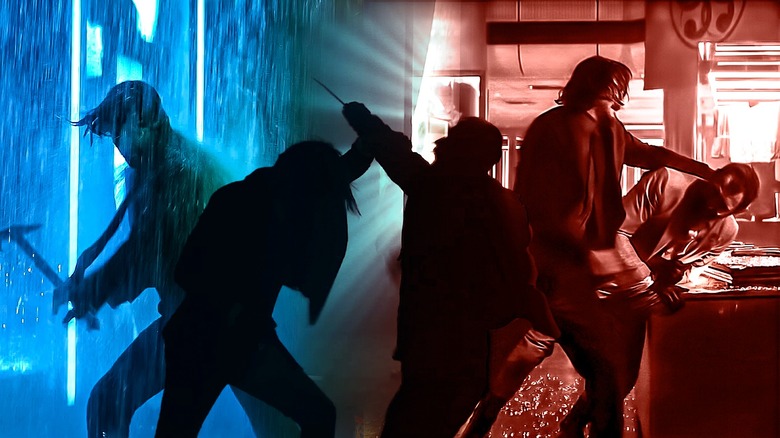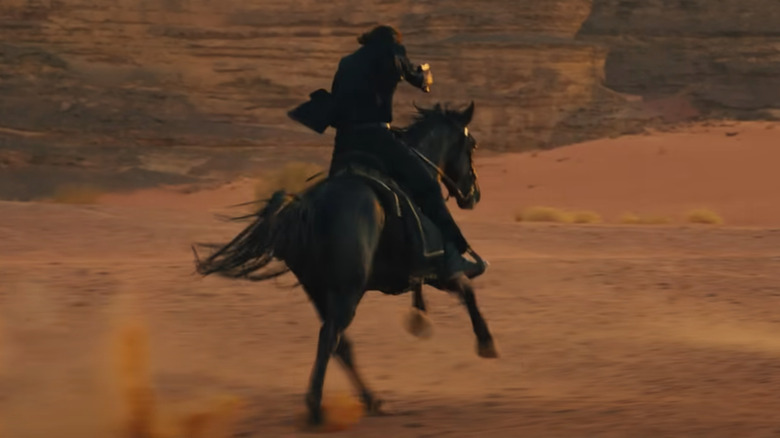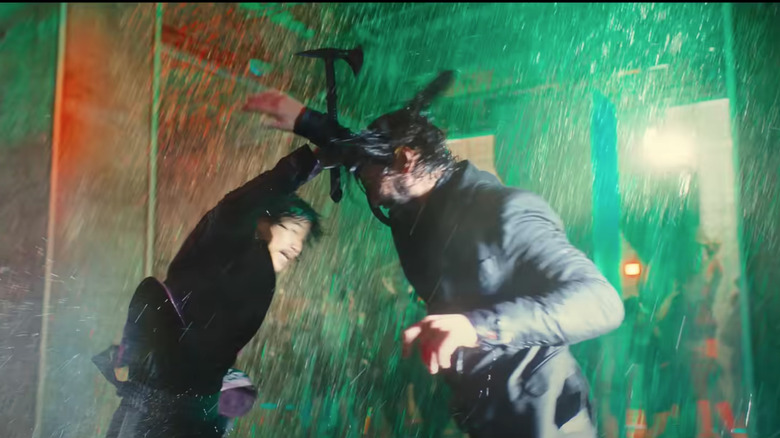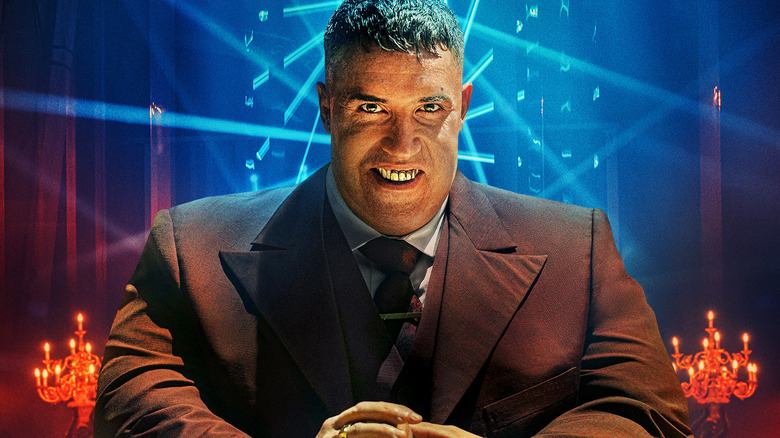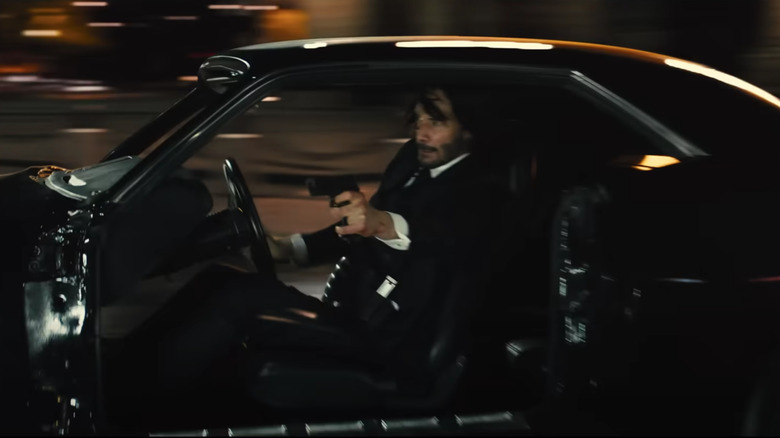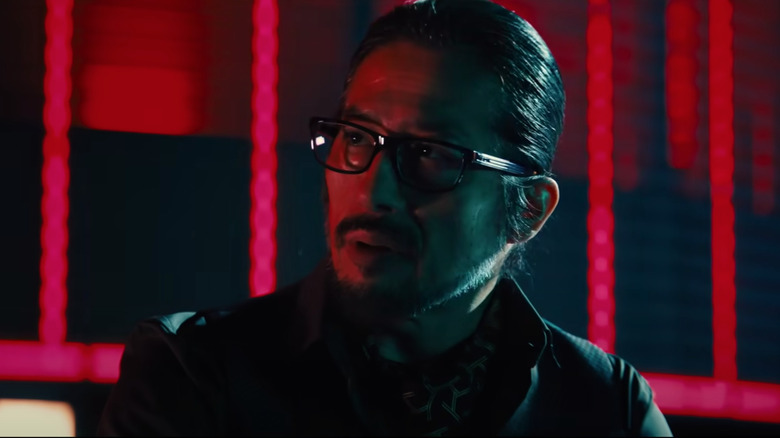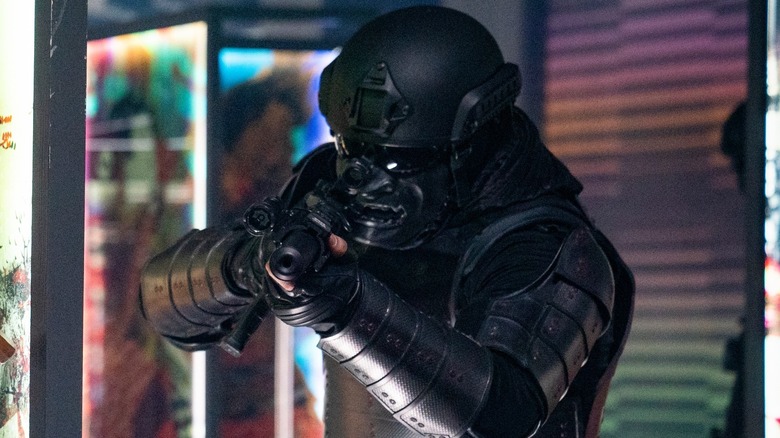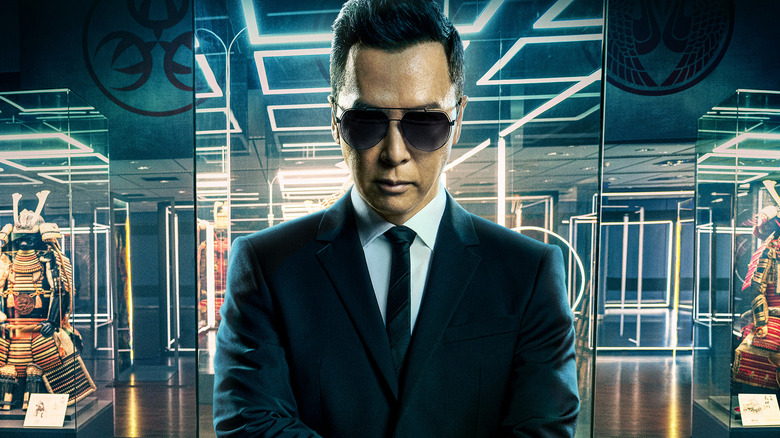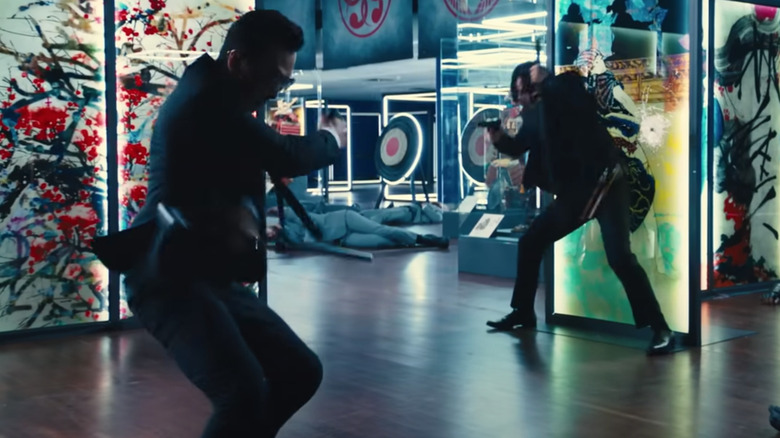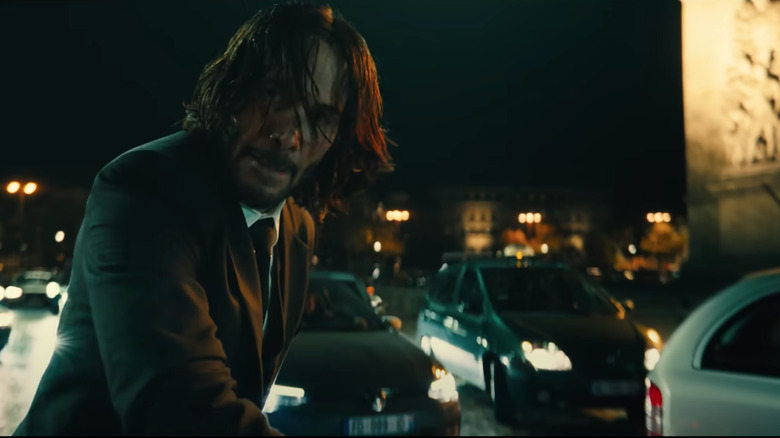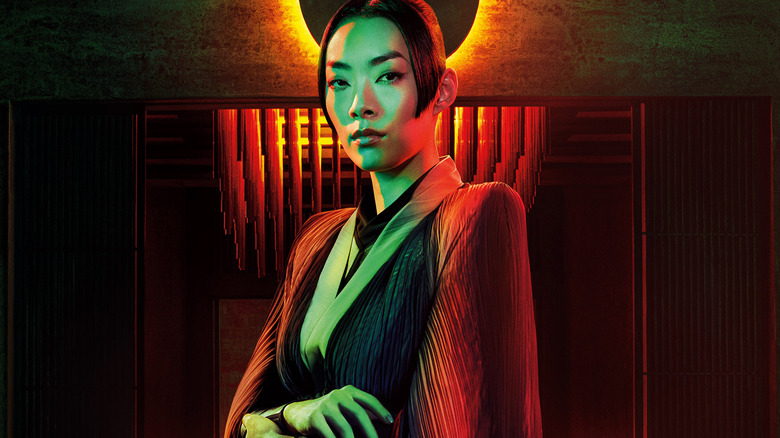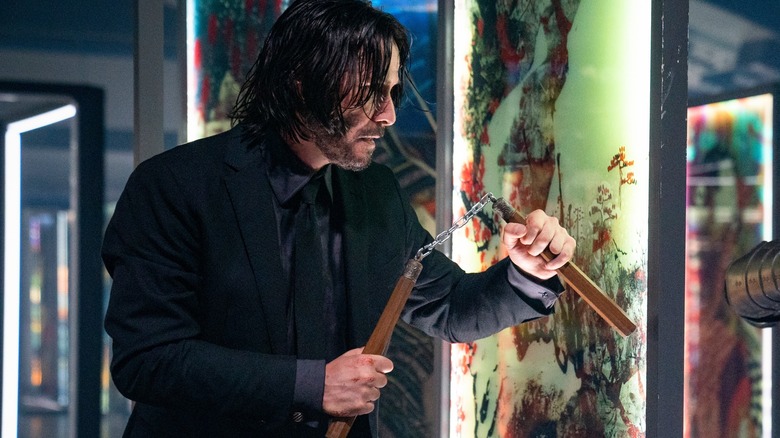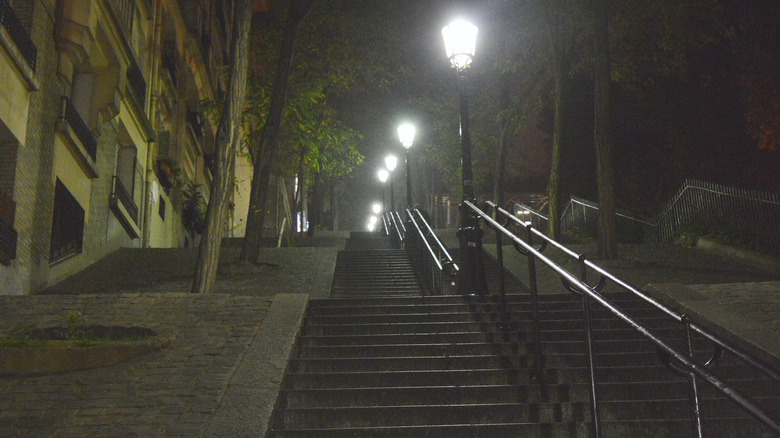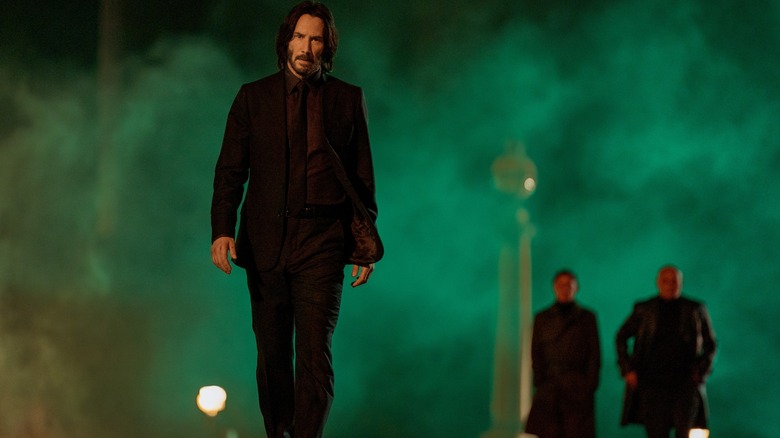John Wick: Chapter 4: The 13 Best Fight Scenes, Ranked
The characters, performances, story, and world-building are all important elements of the "John Wick" series, but what the fans really show up for first and foremost is the action. Following the popularity of the "Bourne" series, shaky camera work and quick cutting became the norm for Hollywood action movies for the next several years. The first "John Wick" movie was a major departure from this trend and offered a much-welcomed return to clear visuals for action cinematography and editing. The success of the original film didn't just lead to a thriving franchise but also helped usher in the next stylistic era of action movies that placed the emphasis back on creative choreography and committed physical performances without ever using tricks of the medium to obscure the fights and shootouts.
As the series progressed, the action sequences continued to get bigger and more complicated in order to keep things fresh and exciting. Luckily, "John Wick: Chapter 4" is no exception and managed to raise the bar once again. This latest outing clocks in at nearly three hours long, and that hefty runtime is used to pack in even more action than usual. Alongside Keanu Reeves in the titular role, Donnie Yen, Rina Sawayama, Marko Zaror, Scott Adkins, Shamier Anderson, and Hiroyuki Sanada all get involved in the action this time around as brand new bottom-kicking characters. From the first swordfight to the final gunfight, these are the best action sequences in "John Wick: Chapter 4," ranked.
13. Horse fu
One of the biggest ways that "John Wick: Chapter 3 – Parabellum" upped the ante from the prior films was by introducing animals into the action sequences. Sofia's (Halle Berry) two attack dogs provided one of the film's standout action sequences, but horses were also used to great effect in a fight in a stable and a subsequent chase sequence through the streets.
"Chapter 4" keeps the animal action going and features a return of both horse and dog-based combat. The new dog — owned by Mr. Nobody (Shamier Anderson) — lives up to the high bar set for canine carnage by the previous film, but the horse combat does not. The first taste of action in "Chapter 4" comes via a horse chase through the desert on John's way to the Elder. Sadly, it pales in comparison to the horse-based action of "Chapter 3." The horse usage is far more standard as opposed to the creative gags devised for "Chapter 3."
As the opening action sequence of the film, it does not get things started with a bang. The big issues with this scene are that is it over too quickly and that it doesn't showcase anything that wasn't already included and executed better in the prior movie. Luckily, the action gets significantly bigger and more impressive from this point on. It's easy to consider this action scene as just a little taste of what's to come to ease back into the world of "John Wick."
12. Berlin
When John needs a family crest to challenge the Marquis to a duel, he finds himself heading to Berlin, Germany, to meet with the Ruska Roma. In order for them to accept him into the family, he first needs to assassinate Killa (Scott Adkins), who killed the former head of the Ruska Roma. Before John can take out Killa, he is required to first engage in an extended fight scene with the numerous armed thugs in his casino and adjoining nightclub.
These thugs use guns, like most of the enemies in the "John Wick" series, but they also fight with intimidating axes, which helps keep things fresh. The location is a standout element of this sequence as the packed dance floor, raining water fixtures from the ceiling, and vibrant neon lighting all contribute to the visually stimulating nature of the action. The fight itself is solid, but it is held back quite a bit by its purpose in the plot being far less compelling than the motivations behind most of the action scenes in the series. To put it simply, the action is strong but it feels unnecessary in this instance, and in a film that is nearly three hours long and can be a little exhausting, this might be one fight scene too many.
11. John vs. Killa
After John successfully takes out Killa's retinue of henchmen, it's time to fight the big guy one-on-one. Just like with the casino/nightclub action scene, this fight is also held back by the fact that it feels like an unnecessary diversion from the main plot in an already overstuffed movie. If you can overlook that one hang-up, the fight itself is otherwise great.
Internationally acclaimed martial artist Scott Adkins makes quite a transformation for the role of Killa. His usual chiseled physique is hidden underneath prosthetics and a fatsuit, and he incorporates the character's weight and asthma into his fighting style. Keanu Reeves vs. Scott Adkins is a matchup of action legends that was always bound to be crowd-pleasing. For some action fanatics, the one-on-one fight between the two of them may be a bit too brief to fully deliver on the expectations that such a clash could entail.
Kung fu fans hoping for a rematch between Adkins and Donnie Yen after their clash in "Ip Man 4: The Finale" in 2019 may walk away a bit disappointed as well. The two share the screen once again and exchange heated words but don't exchange many blows directly. Yen fights off several of Killa's henchmen, but the violence against Killa himself is largely handled by Mr. Wick solo.
10. Car fu
Just like how the horse and dog combat from the previous movies returned in "John Wick: Chapter 4," so did the car combat. Car fu was used for standout sequences in the first and second "John Wick" movies but took a breather in "Chapter 3" to allow for motorcycle action to take center stage instead. "Chapter 4" puts Mr. Wick back behind the wheel of a muscle car during the Paris portion. He also hops back on a motorcycle too for one great stunt where he sends a wheelie-ing bike smashing into a Paris thug at top speed.
This time around, the car-fu choreography retreads some action beats from the past movies. This has the potential to be a larger problem than it is as the sequence avoids feeling too stale by throwing in just enough new ideas. Keanu Reeves doing much of his own stunt driving throughout the series significantly elevates all of the vehicular combat. The standout moment this time around is when John pulls off an extended drift and guns down an entire cluster of enemies as he circles around them repeatedly. Many of the other beats are things fans of the series will have already seen before. These repeated moments mostly retain their punch, but they don't feel as fresh as the action outside of the motor vehicles.
9. Caine vs. Shimazu
Practically all of the action in the "John Wick" series has involved the titular character directly, but "Chapter 4" switches things up by having multiple action sequences that John isn't even present for. Luckily, the new characters are interesting and compelling enough to keep viewers invested even when the main character isn't in the picture. It is also a nice departure to see different fighting styles squaring off, which offers a welcome contrast to John's familiar fighting style.
After Akira (Rina Sawayama) has been wounded, her father Shimazu (Hiroyuki Sanada) stays true to his promise to John and puts his life on the line to keep Caine (Donnie Yen) at bay, who is a mutual friend of both of them but is forced to do the Marquis' bidding. Honoring the classic samurai films that inspired the Osaka portion of "Chapter 4," Shimazu and Caine have a one-on-one sword duel that mixes contemplative stillness with sudden bursts of violent motion.
Caine's blindness and unique fighting style are both incorporated well into the choreography, and the fact that he desperately doesn't want to have to kill Shimazu adds an interesting dimension to the swordfight. It is clear that Caine is holding back, but he is such a vastly superior swordsman that Shimazu doesn't stand a chance anyway. Caine tries more than once to convince Shimazu to simply walk away with his life intact, but Shimazu refuses, and the fight leads to its deadly conclusion the only way it could. This fight has the potential to ripple into the future of the franchise as the post-credits scene teases Akira going after Caine as revenge for the death of her father.
8. Heavy armor
"John Wick: Chapter 3 – Parabellum" was the first film in the series to introduce the heavily-armored soldiers of the High Table. These highly skilled, well-equipped, and nearly bulletproof opponents gave John a new challenge and switched up the rules of the typical movie shootout in a creative fashion. These armored soldiers make a welcome return in Mr. Wick's latest outing. In both films, the High Table soldiers are sent to assault a branch of The Continental; the NYC Continental in "Chapter 3" and the Osaka Continental in "Chapter 4."
Rather than John mostly fighting the heavily-armored soldiers solo with a little help from Charon like in "Chapter 3," there are now many more combatants in the fray. Fighting alongside the soldiers are numerous unarmored opponents and the lethal Chidi (Marko Zaroro) sent by the Marquis. On the opposing side, John is still in the mix, but he now has Shimazu (Hiroyuki Sanada), Akira (Rina Sawayama), many Osaka Continental guards, and even a couple of sumo-style fighters all helping him out. Rather than the one-man-army approach audiences were treated to in John's first encounter with the High Table soldiers in "Chapter 3," the sides are closer to being equal in numbers this time, making for a full-on war that ebbs and flows throughout the Continental, with Caine (Donnie Yen) serving as the wild card that tips the scales in favor of the Marquis.
7. The doorbells
As the blind assassin Caine, Donnie Yen is given not just one but two full fight scenes that don't involve John Wick at all. This solo action paired with his having a much stronger motivation than John helps Caine steal the show in some regard. His swordfight against Shimazu is great, but his fight in the kitchen of the Osaka Continental is even better. This is the first time audiences have gotten to truly see him in action, and he makes one hell of a first impression.
After taking his time to have a quick and calm meal while the bullets fly, he gets to work. One of the most crowd-pleasing moments of the entire film arrives when Caine sticks motion-sensing doorbells to different surfaces throughout the kitchen, which he then uses to locate and shoot his opponents as they trip the sensors. His mix of guns and blades is fun and cathartic, and Yen manages to always keep it clear and believable in his physical performance that his character really is blind. The way he throws himself into walls and feels out the environment adds a nice level of realism alongside all the exaggeration that is seldom seen in the blind fighter archetype, including in Yen's own prior blind fighter character in "Rogue One."
6. Wick vs. Caine
John Wick directly squares off against Caine twice in "Chapter 4." Alongside Cassian (Common) from Chapter 2, Caine is one of the only characters in the series to go head-to-head with John and live to tell the tale. Their second showdown is the duel at La Basilique du Sacré Cœur, which is too slow and methodical to really be considered an action sequence. Their first showdown is where the sparks really fly.
In the Osaka Continental, after John and Caine have both dispatched dozens of their respective adversaries separately, the two finally come face-to-face in the same display room where John earlier put a pair of nunchucks to good use. The friendly history between them is apparent as they do not really wish to hurt each other, but neither can afford to hold back in the fight. The two use drastically different fighting styles but are comparably skilled assassins despite Caine's massive disadvantage when it comes to sight
It is extremely notable that Caine actually comes out on top at the end of the fight. For the first time in the series, John is truly bested in one-on-one combat. He runs out of ammo and is forced to keep silent and play dead while Caine is still armed and ready for more action. If not for the intervention of Mr. Nobody (Shamier Anderson), Caine may have finished off John for good right then and there.
5. Playing in traffic
One of the most creative action sequences in "John Wick: Chapter 4" happens in Paris right in front of the Arc de Triomphe. This iconic French landmark has been featured in plenty of movies before — including showing up recently in the action genre for a motorcycle chase in the "Mission: Impossible" series — but it has never been showcased quite like this before. For one wild and bombastic action sequence, John fights Paris gangsters and the Marquis' henchman in the roundabout surrounding the Arc de Triomphe as traffic continues to blaze past them. John and the other combatants weave in and out of traffic on foot, are struck by or launched into cars, and use speeding vehicles as cover from gunfire. Even Mr. Nobody's dog utilizes the traffic by running and leaping across the roofs of cars.
This is one action sequence that is uniquely suited to the exaggerated world of the "John Wick" series. In a more grounded action film, the sheer number of car collisions and the fact that most of the drivers just keep circling the roundabout after plowing through people would stretch the bounds of plausibility. But in the heightened reality of "John Wick," it feels logical enough to avoid ruffling any feathers.
4. Bows and arrows
Each movie in the "John Wick" series has expanded the arsenal. "Chapter 2" introduced bulletproof suits and a bevy of new firearms. "Chapter 3" introduced swords, axes, throwing knifes, and even John's belt as an improvised weapon in one memorable fight scene. "Chapter 4" continues the trend by introducing a whole host of new weapons: first bows and arrows, and later on nunchucks and Dragon's Breath shotgun shells.
The weapon of choice for the Osaka Continental guards is the old-fashioned bow-and-arrow combo, but their special steel-tipped arrows are strong enough to pierce solid walls. Akira (Rina Sawayama) makes especially good use of her bow throughout the choreography. One standout moment involves her saving John by sending an arrow through a heavily-armored soldier's knee, pinning him to a wall and leaving him dangling upside down after he's killed.
The only slightly disappointing aspect of this sequence is that Mr. Wick never uses a bow himself, but Akira does enough ass kicking with hers to make up for it. This action sequence also showcases her close-quarters combat abilities as well. Her slick, acrobatic fighting style is a nice change of pace from the more brutish, strength-based fighting styles of thugs like Chidi (Marko Zaror) and the Judo-focused throws of John Wick. John has plenty of cool moments in this fight, but Akira is the real star of this particular action sequence. With both Akira and Caine leaving fantastic impressions in "Chapter 4," the potential spin-off conflict between them teased in the post-credits scene seems like a perfect extension of the franchise.
3. Nunchucks
During a fight scene in a large museum-type room within the Osaka Continental, display cases of old armor and weapons are shattered. When he finds himself unarmed, Mr. Wick takes up a pair of nunchucks from one of the broken display cases and proves himself to be an expert with the uncommon weapon. Given that "John Wick: Chapter 2" previously homaged Bruce Lee's "Enter the Dragon" with the hall of mirrors action sequence, it's possible that the incorporation of nunchucks in "Chapter 4" is another nod to Lee, who was one of the few martial artists to consistently feature nunchucks throughout his entire body of work.
Nunchucks are a ubiquitous screen weapon, but any action movie aficionado will tell you that nunchucks are featured less in real fight scenes and are more frequently used for some variation of the joke where the person wielding them flails wildly and ends up hurting themself. The reason is likely that it is difficult to choreograph and safely execute exciting action with such an unpredictable weapon, but the "John Wick" team was up to the challenge. Keanu Reeves clearly put in the work to become adept with nunchucks, and the film delivers numerous cool and creative moments using the weapon in ways that have never before been put to screen.
2. The staircase
Before the closing duel, the big, climactic action set piece takes place at Rue Foyatier, a 222-step staircase that leads up to La Basilique du Sacré Cœur de Montmartre, which is a popular tourist attraction in real life. John has to reach the top of the stairs by sunrise, and there are dozens of assassins standing between him and his goal who all want the astronomical bounty on his head. The verticality of the staircase and the steep slopes beside it are well-integrated into the choreography, and John's goal at the top provides a sense of forward and upward momentum that none of the other action scenes in the series have.
When John finally reaches the top and seemingly completes his goal, the film pulls the rug out from under him and the audience. As Chidi (Marko Zaror) sends John tumbling all the way back down to the very bottom of the staircase, we realize this spectacular action sequence is only halfway through. Luckily, he has help to make the ascent for the second time. Though they are set to duel at the top, Caine helps John get there. Seeing these two skilled fighters work together is a treat, and Mr. Nobody and his dog even join the fray toward the end of the sequence to take out Chidi.
1. Dragon's Breath
The big staircase finale is an incredible action set piece, but it just can't top the earlier Paris gunfight where John finds himself armed with a Dragon's-Breath spewing shotgun. Rather than normal ammunition that pierces targets, Dragon's Breath shells cause fiery eruptions. With incendiary explosions and more full-body burn stunts than you can shake a stick at, this shootout finds the "John Wick" series once again changing the rules of the standard movie shootout and delivering a spectacle, unlike anything action cinema has ever offered before.
This gunfight also has a leg up over other shootouts when it comes to the cinematography style. For the first and only time in the "John Wick" series, the camera adopts a top-down perspective to capture the action. The shootout is presented in just a handful of extremely long takes showcased in full detail from above as John moves from room to room and sets his foes ablaze. The camera occasionally cuts back down to a more grounded perspective and to allow the more character-driven moments to unfold, such as the conflict with Mr. Nobody and John's choice to save his dog. Regardless of any hidden cuts used to make the long takes appear seamless, the coordination involved to pull this off is truly mind-blowing and endlessly impressive.
